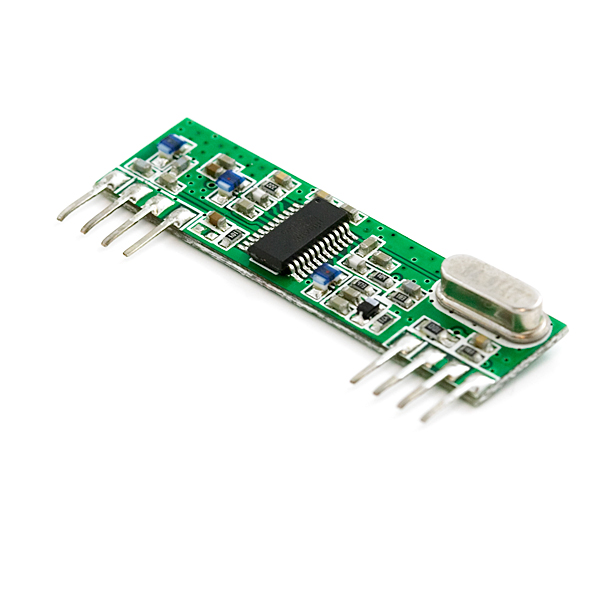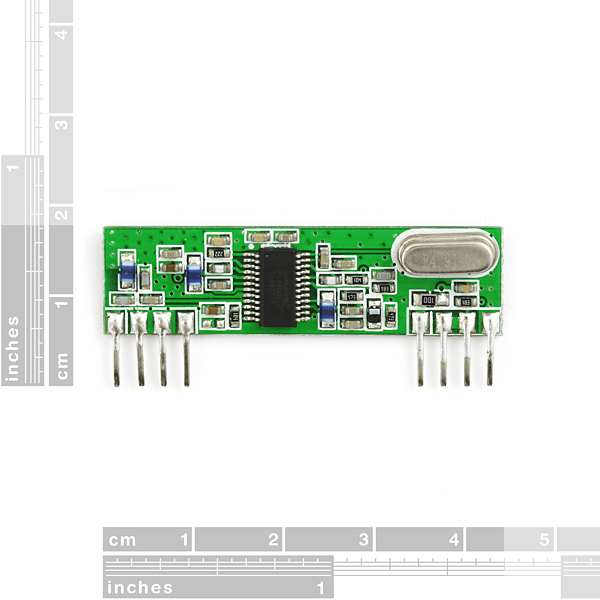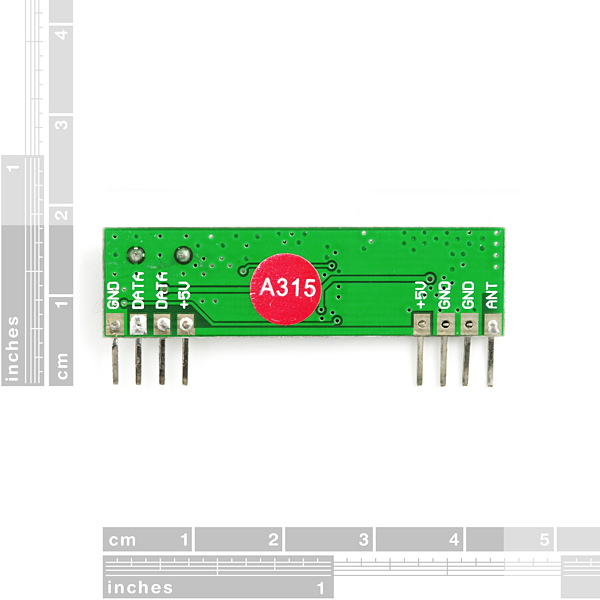×
SparkFun will be closed on Tuesday, December 24th, and Wednesday, December 25th, in observance of the Christmas holiday. Any orders qualifying for same day shipping placed after 2:00 p.m. (MST) on Monday, December 23rd, will be processed on Thursday, December 26th, when we return to regular business hours. Wishing you a safe and happy holiday from all of us at SparkFun!
Please note - we will not be available for Local Pick up orders from December 24th-December 27th. If you place an order for Local Pick-Up we will have those ready on Monday, December 30th.
RF Link 4800bps Receiver - 315MHz
Replacement: None. We are looking for a new supplier for these, but don't have a replacement yet. This page is for reference only.
Sold as a receiver only. This receiver type is good for data rates up to 4800bps and will only work with the 315MHz transmitter. Multiple 315MHz receivers can listen to one 315MHz transmitter.
This wireless data is the easiest to use, lowest cost RF link we have ever seen! Use these components to transmit position data, temperature data, even current program register values wirelessly to the receiver. These modules have up to 500 ft range in open space. The receiver is operated at 5V.
We have used these modules extensively and have been very impressed with their ease of use and direct interface to an MCU. The theory of operation is very simple. What the transmitter 'sees' on its data pin is what the receiver outputs on its data pin. If you can configure the UART module on a PIC, you have an instant wireless data connection. Data rates are limited to 4800bps. The typical range is 500ft for open area.
This receiver has a sensitivity of 3uV. It operates from 4.5 to 5.5 volts-DC and has digital output. The typical sensitivity is -103dbm and the typical current consumption is 3.5mA for 5V operation voltage.
- 315 MHz Operation
- 500 Ft. Range - Dependant on Transmitter Power Supply
- 4800 bps transfer rate
- Low cost
- Extremely small and light weight
- KLP Walkthrough Tutorial
- Good AVR Tutorial
- Receiver Datasheet
- Another Very Helpful AVR Tutorial - Thanks Eric Forkosh!
Comments
Looking for answers to technical questions?
We welcome your comments and suggestions below. However, if you are looking for solutions to technical questions please see our Technical Assistance page.
Customer Reviews
No reviews yet.




These are very finicky and very suspeptable to noise. In my opinion, not worth the headache over an Xbee. But if you really want to make use of these, you must do these two things:
1. Tune your antenna to the proper length. You can use this site to calculate a suitable length depending on frequency. (http://www.csgnetwork.com/freqwavelengthcalc.html). Full wave is most optimal, but 1/2 or 1/4 is next best. You can experiment by adding/trimming length to the antennas. This will reduce your SWR. (http://en.wikipedia.org/wiki/Standing_wave_ratio)
2. Packetize your data and use checksums. On the receiving end, compute the checksum to make sure the data is clean before you "trust" it.
The device appears to do some adaptation, so if you send 10-15 "warm up" characters before the "real" data, this appears to improve the chances of the real data to be clean.
I get about 1200-1800 baud of usable data when using 4800 baud input at 40 feet indoors.
I had difficulty getting correct/accurate data out of this chip. I stumbled upon this site and found it EXTREMELY useful. Now, 100% accurate data. I hated this transmitter until I found this site. Its for PICAXE but can be adapted
http://quicktrip.co.nz/jaqblog/index.php?option=com_idoblog&task=viewpost&id=25&Itemid=8
Updated URL: http://quicktrip.co.nz/jaqblog/home/25
the link is broken :(
If you trim down the link a bit to http://quicktrip.co.nz/jaqblog/index.php you'll notice that it works! The only problem is that it's on a blog style page (which is quite crowded) and you have to scroll down one third of the way to find it. Other than that, the page does look quite useful.
Maybe the same problem, but I don't know which side might have the problem, and I was just trying to see it using an LED - but does this have ANY drive capability? The datasheet says 10 microamps for both states.
The problem seems to be ASK or OOK, but it isn't quite that. If I keep the transmitter constantly on, I will only get a short pulse out of the receiver (if that). I would expect a switch on the transmitter would turn on and off something on the receiver 1-for-1 up to 4800 baud, but down to DC. Reading the info, there seems to be a requirement for some (unknown) switching of the data, i.e. a minimum frequency.
Sad that these still aren't back yet. Bummer that I only got two of these before they disappeared.
Could you guys source a module that can at least receive in the 315 MHz range so I can make use of the transmitters that are still available? I know there was a transceiver module that supported 433 MHz, 868 MHz and 915 MHz [ http://www.sparkfun.com/products/10153 ]. Be nice to have one at 315 MHz too.
DEPRECATED?? Noooooo these are so wonderful!
IKR !!!!
ETA?
Estimated Time (to/of) Arrival
OMG!!! NO!! why are they retired, i need these lol ... how much longer until they are back into stock .................WHY is this happening to me lol
We tried to get these forever, but our supplier doesn't make them anymore. We are looking for replacements. We don't have an ETA.
VirtualWire for Arduino turns these things into the easiest thing in the world to use! They're not fast but they work great for home automation type projects and even some basic robot control.
Is this transmitter and receiver pair FCC certified? I read in another section that it is but I want to be sure before I use it.
If it is, does FCC give you a certificate saying it is ok to use this for hobby projects?
Thanks.
I got this working on a pair of Arduinos using the VirtualWire library. The PDF documentation for VirtualWire includes a very basic "hello" transmitter and reciever.
This thread was useful:
http://www.arduino.cc/cgi-bin/yabb2/YaBB.pl?num=1208473338
I had some great frustration followed by great joy when I finally got these to work. It was thanks to this post on the Arduino forum:
http://www.arduino.cc/cgi-bin/yabb2/YaBB.pl?num=1243851975
In case it helps anyone!
I had started with an antenna length of 13" and couldn't get it to receive. I then cut it back to 6" and was able to receive about 40' away with 3.3V transmitter supply.
Hi guys,
This one along with the matched xmitter are not working for me :( I am using two Arduino boards to interface to them but cannot seem to receive anything. I followed every tutorial out there and nothing :( Please let me know if you had similar issues. If you got them to work and you have a hint please let me know also.
Thanks.
Hey im running into the same issue... Im using 2 PIC18F2525 tho... I have ensured UART is working by wiring the 2 together. They both are sending/receiving at 2400bps and 4800bps.. Both works with when wired.
When i try to drop this in its a kill joy... Nothing is working. I also tried all the tutorials and info..
You think faulty product?